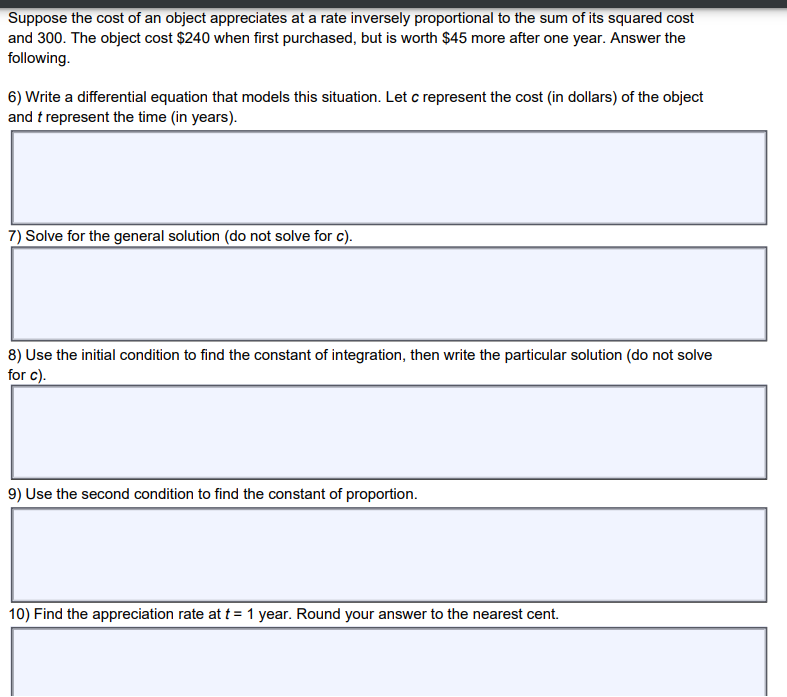Suppose the cost of an object appreciates at a rate inversely proportional to the sum of its squared cost and 300. The object cost $240 when first purchased, but is worth $45 more after one year. Answer the following. 6) Write a differential equation that models this situation. Let c represent the cost (in dollars) of the object and t represent the time (in years). 7) Solve for the general solution (do not solve for c). 8) Use the initial condition to find the constant of integration, then write the particular solution (do not solve for c). 9) Use the second condition to find the constant of proportion. 10) Find the appreciation rate at t = 1 year. Round your answer to the nearest cent.
Suppose the cost of an object appreciates at a rate inversely proportional to the sum of its squared cost and 300. The object cost $240 when first purchased, but is worth $45 more after one year. Answer the following. 6) Write a differential equation that models this situation. Let c represent the cost (in dollars) of the object and t represent the time (in years). 7) Solve for the general solution (do not solve for c). 8) Use the initial condition to find the constant of integration, then write the particular solution (do not solve for c). 9) Use the second condition to find the constant of proportion. 10) Find the appreciation rate at t = 1 year. Round your answer to the nearest cent.
Calculus: Early Transcendentals
8th Edition
ISBN:9781285741550
Author:James Stewart
Publisher:James Stewart
Chapter1: Functions And Models
Section: Chapter Questions
Problem 1RCC: (a) What is a function? What are its domain and range? (b) What is the graph of a function? (c) How...
Related questions
Question
answer the first 3 using the information

Transcribed Image Text:Suppose the cost of an object appreciates at a rate inversely proportional to the sum of its squared cost
and 300. The object cost $240 when first purchased, but is worth $45 more after one year. Answer the
following.
6) Write a differential equation that models this situation. Let c represent the cost (in dollars) of the object
and t represent the time (in years).
7) Solve for the general solution (do not solve for c).
8) Use the initial condition to find the constant of integration, then write the particular solution (do not solve
for c).
9) Use the second condition to find the constant of proportion.
10) Find the appreciation rate at t = 1 year. Round your answer to the nearest cent.
Expert Solution
This question has been solved!
Explore an expertly crafted, step-by-step solution for a thorough understanding of key concepts.
This is a popular solution!
Trending now
This is a popular solution!
Step by step
Solved in 3 steps with 2 images

Recommended textbooks for you

Calculus: Early Transcendentals
Calculus
ISBN:
9781285741550
Author:
James Stewart
Publisher:
Cengage Learning

Thomas' Calculus (14th Edition)
Calculus
ISBN:
9780134438986
Author:
Joel R. Hass, Christopher E. Heil, Maurice D. Weir
Publisher:
PEARSON

Calculus: Early Transcendentals (3rd Edition)
Calculus
ISBN:
9780134763644
Author:
William L. Briggs, Lyle Cochran, Bernard Gillett, Eric Schulz
Publisher:
PEARSON

Calculus: Early Transcendentals
Calculus
ISBN:
9781285741550
Author:
James Stewart
Publisher:
Cengage Learning

Thomas' Calculus (14th Edition)
Calculus
ISBN:
9780134438986
Author:
Joel R. Hass, Christopher E. Heil, Maurice D. Weir
Publisher:
PEARSON

Calculus: Early Transcendentals (3rd Edition)
Calculus
ISBN:
9780134763644
Author:
William L. Briggs, Lyle Cochran, Bernard Gillett, Eric Schulz
Publisher:
PEARSON

Calculus: Early Transcendentals
Calculus
ISBN:
9781319050740
Author:
Jon Rogawski, Colin Adams, Robert Franzosa
Publisher:
W. H. Freeman


Calculus: Early Transcendental Functions
Calculus
ISBN:
9781337552516
Author:
Ron Larson, Bruce H. Edwards
Publisher:
Cengage Learning